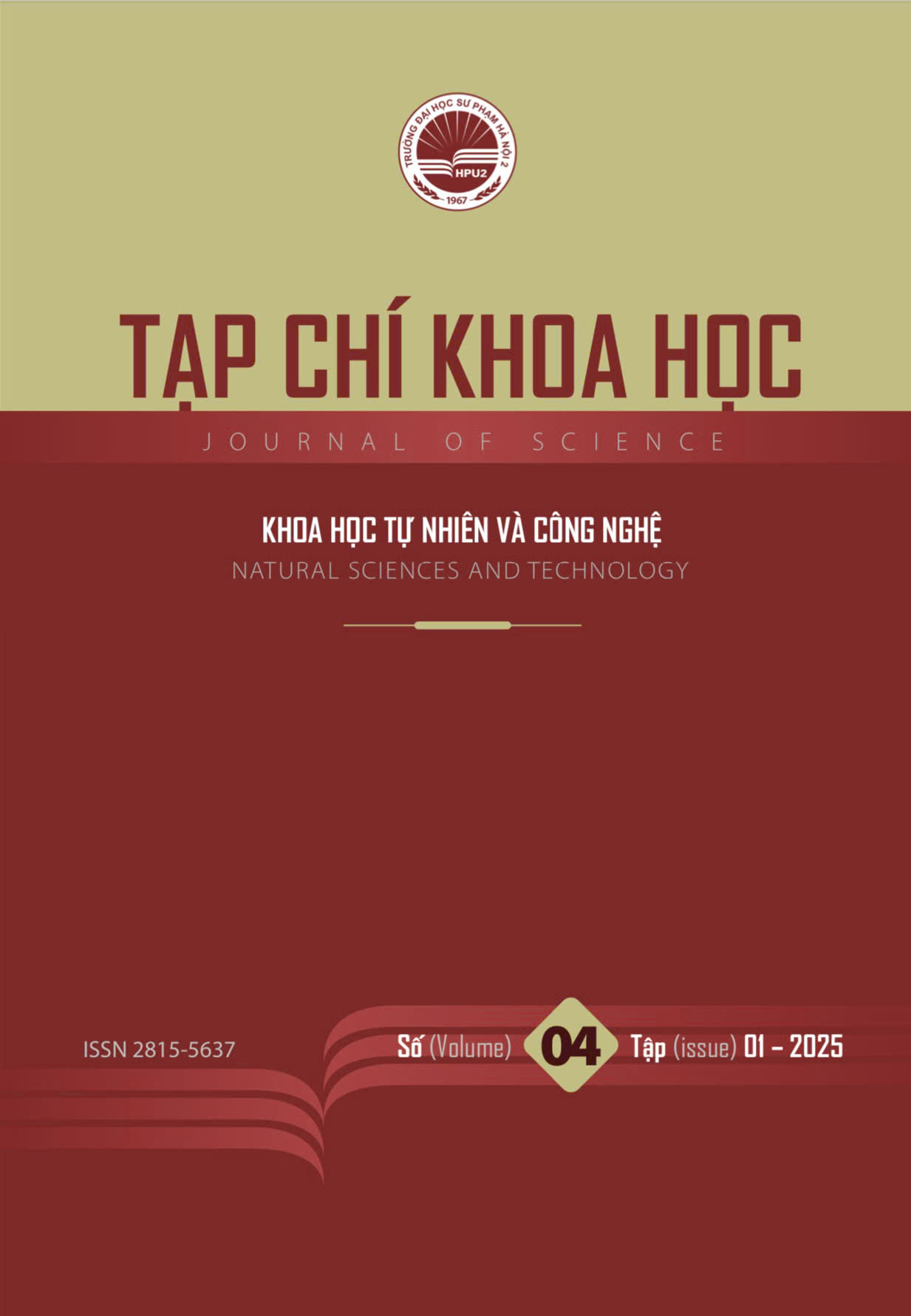Optimization of extraction of flavonoid and polyphenol from Camellia megasepala leaves and their anticancer activity
DOI:
https://doi.org/10.56764/hpu2.jos.2025.4.01.12-19- Keywords:
- Optimization
- flavonoid
- polyphenol
- cancer
- Camellia
Abstract
Camellia megasepala Hung T. Chang & Trin Ninh, found in Na Hang district, Tuyen Quang province, contains a significant amount of flavonoids and polyphenols, which are important phenolic compounds known for their various biological activities beneficial to human health, including antibacterial and anti-inflammatory effects. This study applied the response surface methodology (RSM) to examine the influence of extraction factors on the polyphenol and flavonoid content in golden tea leaves. The optimal conditions for extracting polyphenols and flavonoids were temperature at 60°C, 70% ethanol concentration, extraction time of 80 minutes, and a material/solvent ratio of 1/20 (w/v). The experimental values were: flavonoid = 1.42 ± 0.0172 mgQE/g extract; polyphenol = 4.29 ± 0.0348 g/100g extract. The extract from golden tea leaves was evaluated for its cytotoxic activity against HepG2 liver cancer cells and A549 lung cancer cells. The inhibitory concentration (IC50) for the ethanol 70% extract was recorded as IC50 = 74.11 ± 1.37 µg/ml and IC50 = 67.11 ± 1.57 µg/ml for HepG2 and A549 cells, respectively. The results of this study suggest the potential application of golden tea leaf extract in inhibiting the growth of liver and lung cancer cells.
References
[1] P. Nguyen et al., “A Comprehensive Strategy for Metabolites Profiling of Flowers and Leaves from Camellia tienii, an Endemic Golden Tea of Vietnam,” Chemistry and Biodiversity, Sep. 2024, Art no. 16121872, 16121880, doi: 10.1002/cbdv.202400997.
[2] B. Tian et al., “Yellow leaf green tea modulates the AMPK/ACC/SREBP1c signaling pathway and gut microbiota in high‐fat diet‐induced mice to alleviate obesity,” Journal of the Science of Food and Agriculture, vol. 104, no. 10, pp. 5882–5895, Mar. 2024, doi: 10.1002/jsfa.13413.
[3] T. Thang and M. Quynh, “Distribution and potential of camellia spp. In the central highlands, Vietnam, for developing high-value products in the food industry,” Dalat University Journal of Science, 14(1), pp. 72–88, Mar. 2024, doi: 10.37569/dalatuniversity.14.1.1278.
[4] X. Zhai et al., “Insights into the Key Odorants in Large-Leaf Yellow Tea (Camellia sinensis) by Application of the Sensomics Approach,” Journal of agricultural and food chemistry, vol. 71, no. 1, pp. 690–699, Dec. 2022, doi: 10.1021/acs.jafc.2c05881.
[5] J. Milán-Carrillo, A. Montoya-Rodríguez, R. Gutiérrez-Dorado, X. Perales-Sánchez, and C. Reyes-Moreno, “Optimization of Extrusion Process for Producing High Antioxidant Instant Amaranth (Amaranthus hypochondriacus L.) Flour Using Response Surface Methodology,” Applied Mathematics, vol. 03, no. 10, pp. 1516–1525, 2012, doi: 10.4236/am.2012.330211.
[6] N. Siddiqui and V. Aeri, “Optimization of Betulinic Acid Extraction from Tecomella undulata Bark Using a Box-Behnken Design and Its Densitometric Validation,” Molecules, vol. 21, no. 4, p. 393, Apr. 2016, doi: 10.3390/molecules21040393.
[7] None Aparna, V. Kumar, and Raman Nautiyal, “Isolation and chemical characterization of lignocellulosic fiber from Pueraria montana using Box-Behnken design for weed management,” International Journal of Biological Macromolecules, vol. 268, pp. 131479–131479, Apr. 2024, doi: 10.1016/j.ijbiomac.2024.131479.
[8] M. Jiang et al., “Optimization of the extraction process for Shenshou Taiyi powder based on Box-Behnken experimental design, standard relation, and FAHP-CRITIC methods,” BMC Complementary Medicine and Therapies, vol. 24, no. 1, Jul. 2024, Art no. 26627671, doi: 10.1186/s12906-024-04554-7.
[9] X. Chen, X. Zhou, and Y. Gao, “Optimizing Coreopsis tinctoria Flower Extraction and Inhibiting CML Activity: Box-Behnken Design,” Anti-Cancer Agents in Medicinal Chemistry, vol. 24, no. 15, pp. 1151–1158, Sep. 2024, doi: 10.2174/0118715206299886240620070011.
[10] S. Liang et al., “Optimization of a tannase-assisted process for obtaining teas rich in theaflavins from Camellia sinensis leaves,” Food Chemistry X, vol. 13, pp. 100203–100203, Jan. 2022, doi: 10.1016/j.fochx.2022.100203.
[11] S. Raghunath, Sravanthi Budaraju, M. Taghi, M. Koubaa, Shahin Roohinejad, and Kumar Mallikarjunan, “Processing Technologies for the Extraction of Value-Added Bioactive Compounds from Tea,” vol. 15, no. 2, pp. 276–308, Feb. 2023, doi: 10.1007/s12393-023-09338-2.
[12] H. Cui et al., “Flavonoids from Morus alba L. Leaves: Optimization of Extraction by Response Surface Methodology and Comprehensive Evaluation of Their Antioxidant, Antimicrobial, and Inhibition of α-Amylase Activities through Analytical Hierarchy Process,” Molecules, vol. 24, no. 13, pp. 2398–2398, Jun. 2019, doi: 10.3390/molecules24132398.
[13] P. Sithisarn, P. Nantateerapong, P. Rojsanga, and P. Sithisarn, “Screening for Antibacterial and Antioxidant Activities and Phytochemical Analysis of Oroxylum indicum Fruit Extracts,” Molecules, vol. 21, no. 4, p. 446, Apr. 2016, doi: 10.3390/molecules21040446.
[14] Sultana, B., Anwar, F., & Przybylski, R., “Antioxidant activity of phenolic components present in barks of Azadirachta indica, Terminalia arjuna, Acacia nilotica, and Eugenia jambolana Lam. trees”, Food Chemistry, 104, 1106-1114. 2007, doi: 10.1016/j.foodchem.2007.01.019.
[15] Q. Li, L.-Z. Zhu, R.-J. Yang, and X. Zhu, “Cytotoxic Activity of Anticancer Drugs on Hepatocellular Carcinoma Cells in Hypoxic-Hyponutritional Culture,” International Surgery, vol. 99, no. 6, pp. 745–752, Nov. 2014, doi: 10.9738/intsurg-d-14-00073.1.
[16] Q.-W. Zhang, L.-G. Lin, and W.-C. Ye, “Techniques for Extraction and Isolation of Natural products: a Comprehensive Review,” Chinese Medicine, vol. 13, no. 1, Apr. 2018, Art no. 17936853, doi: 10.1186/s13020-018-0177-x.
[17] Z.-L. Sheng, P.-F. Wan, C.-L. Dong, and Y.-H. Li, “Optimization of total flavonoids content extracted from Flos Populi using response surface methodology,” Industrial Crops and Products, vol. 43, pp. 778–786, May 2013, doi: 10.1016/j.indcrop.2012.08.020.
[18] Y. Wang et al., “Subcritical ethanol extraction of flavonoids from Moringa oleifera leaf and evaluation of antioxidant activity,” Food Chemistry, vol. 218, pp. 152–158, Mar. 2017, doi: 10.1016/j.foodchem.2016.09.058.
[19] J. Lai, H. Wang, D. Wang, F. Fang, F. Wang, and T. Wu, “Ultrasonic Extraction of Antioxidants from Chinese Sumac (Rhus typhina L.) Fruit Using Response Surface Methodology and Their Characterization,” Molecules, vol. 19, no. 7, pp. 9019–9032, Jun. 2014, doi: 10.3390/molecules19079019.
[20 I. Tomaz, L. Maslov, D. Stupić, D. Preiner, D. Ašperger, and J. Karoglan Kontić, “Multi-response optimisation of ultrasound-assisted extraction for recovery of flavonoids from red grape skins using response surface methodology,” Phytochemical Analysis, vol. 27, no. 1, pp. 13–22, Aug. 2015, doi: 10.1002/pca.2582.
[21] Y. Chen, C. Chen, J. Xiang, R. Gao, G. Wang, and W. Yu, “Functional Tea Extract Inhibits Cell Growth, Induces Apoptosis, and Causes G0/G1 Arrest in Human Hepatocellular Carcinoma Cell Line Possibly through Reduction in Telomerase Activity,” Foods, vol. 13, no. 12, pp. 1867–1867, Jun. 2024, doi: 10.3390/foods13121867.
[22] T. Giang et al., “Lipid Peroxidation Inhibitory and Cytotoxic Activities of Two Camellia Species Growing Wild in Vietnam,” Pharmacognosy Magazine, vol. 19, no. 2, pp. 385–399, Apr. 2023, doi: 10.1177/09731296231158437.
Downloads
Published
How to Cite
Volume and Issue
Section
Copyright and License
Copyright (c) 2025 Xuan-Phong Ong , Thi-Thuong Ngo, Viet-Hong La

This work is licensed under a Creative Commons Attribution-NonCommercial 4.0 International License.







